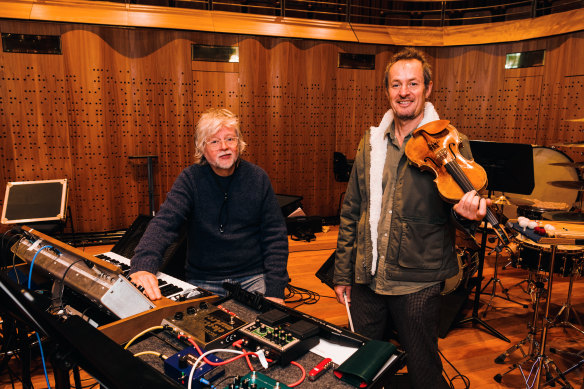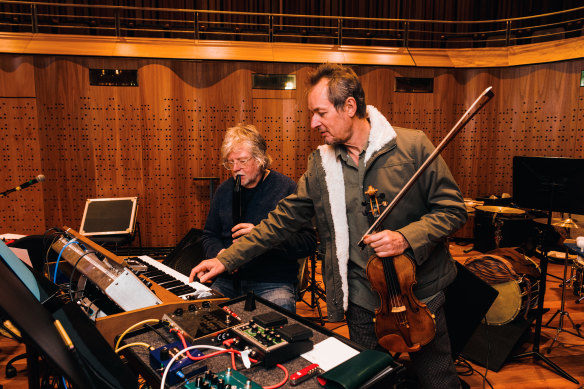Save articles for later
Add articles to your saved list and come back to them any time.
Will Gregory is sitting in a room full of synthesisers – some old, some even older, and a handful new – arranged in a manner you would hardly call neat.
“I’ve got a lot of them here,” admits the composer for TV and film, non-singing half of the electro-folk/dance-pop band Goldfrapp, and leader of the Will Gregory Moog Ensemble.
“But they are all switched off. On hot days, if you turn them all on it gets really hot because there are so many valves going.”
Will Gregory and Australian Chamber Orchestra artistic director Richard Tognetti at the ACO Pier 2/3.Credit: James Brickwood
That may explain why he keeps the bulk of his substantial collection off site. But it doesn’t explain why he has so many synths.
The combination of such an array of tools/toys with Gregory’s interest in mixing genres raises the possibility of a series of albums called Switched-On Gregory, in the mould of composer and keyboardist Wendy Carlos’ Switched-On Bach, the groundbreaking 1968 work enmeshing classical music with electronic equipment.
That album was built on explorations of the then-new, barely understood Moog synthesiser, a creator and shaper of sounds that looked like a giant old style telephone exchange panel and that made noises that sounded like a future no one had imagined yet.
The record remains pivotal in Gregory’s multifaceted life, as it was for early adopters such as prog-rock groups Yes, as well as Emerson, Lake & Palmer, pop artists such as the Beatles and the Monkees, and jazz musicians like Herbie Hancock and Sun Ra.
“Well,” he chuckles. “I wouldn’t like to tread too heavily on those coat-tails. I think standing on the shoulders of giants, we need to be a little respectful there. But I think a lot of people love music and when I have done interviews with the pop press they always imagine that you only like one kind of music, or that their audience only likes one kind of music. I think we are a lot more catholic in our tastes.”
Will Gregory from Goldfrapp brings his synthesiser ensemble to Sydney, in collaboration with the Australian Chamber Orchestra.Credit: James Brickwood
And more catholic in their choice of collaborators, as this month sees Gregory’s Moog Ensemble joining the Australian Chamber Orchestra for a series of concerts focusing on the shared territory of electronic innovation, film scores and the classical repertoire.
Among the pieces on the program will be Carlos’ bold electronic arrangements of Bach and her adventurous scores for Tron and Stanley Kubrick’s A Clockwork Orange, as well as Delia Derbyshire and Ron Grainer’s Doctor Who theme. Other works on the bill pitch back and forward from Carlos, Derbyshire and Grainer, including Olivier Messiaen and Franz Waxman (who scored Sunset Boulevard and Rear Window among many others), Vangelis (from the scores for Blade Runner and Chariots Of Fire), Hans Zimmer (Interstellar) and John Williams (Images).
“There are a lot of subterranean fans for this kind of stuff – I’m hoping,” says the ACO’s artistic director Richard Tognetti.
He came up with the idea for the program during lockdown while watching the early Robert Altman film Images, a psychological thriller/horror which blended the work of Japanese avant-garde percussionist Stomu Yamashta and Williams.
Originally conceived as a showcase of lesser-known Williams compositions, the concept shifted from scores that changed film history (“Of course we looked no further than Wendy Carlos”) to a full electronic/orchestra blend (“In the Vangelis Blade Runner, there’s one of the great synth sounds”) when Tognetti was introduced to the Moog Ensemble.
“I found out he was also Mr Goldfrapp, and I thought this is too good an opportunity to pass up. The way Will talks about his instrument, with the imperfections, is just wonderful,” Tognetti says.
The imperfections of the early synthesisers partly inspired Carlos to explore their many possibilities.
“I think that’s what it’s all about: it’s the [Japanese philosophy on acceptance of transience and imperfection] wabi-sabi,” Tognetti says.
He nods to the ondes martenot, the keyboard-operated oscillating waves instrument that Messiaen first used in 1937’s Fete des belles eaux.
“It was the imperfection, what you got in between the notes, that attracted [Messiaen]. The imperfection, these almost deliberate blemishes, within the perfect realm, that’s what Will talks about.”
Gregory himself raves about the “brilliant marrying of force” that is Blade Runner – “these huge, epic long spaces that you could throw a sound into and it blooms and expands and becomes like panoramic 3D things, just one sound”.
He also thrills at the boldness of the score for Tron, which he sees as “Wendy Carlos really enjoying the freedom to be a composer and putting on all these different hats”.
“So you get medievally things, you get quite hyper-arranged, bombastic orchestral things, with synths involved. That feels to me like the wonder that Wendy Carlos was given that job to be a film composer and take on all those resources, and go a bit insane with that actually,” he says.
“With Wendy I think the genius lies in the instrumentation. The pinnacle of Wendy is the Switched-On Bach records – they are just sublime.”
A Clockwork Orange and Beyond is at City Recital Hall, May 12 to 17; Sydney Opera House, May 14; and Wollongong Town Hall, May 18.
Sydney Morning Herald subscribers can enjoy 2-for-1 tickets* to the Archibald, Wynne and Sulman Prizes exhibition at the Art Gallery of New South Wales during June 2023. Click here for more details.
Find out the next TV, streaming series and movies to add to your must-sees. Get The Watchlist delivered every Thursday.
Most Viewed in Culture
From our partners
Source: Read Full Article




